NYC Health + Hospitals Hosts Asylum Seeker Art Exhibition for Artists Living at Hall St. Humanitarian Center
The Asylum Seeker Art Exhibition was organized by NYC Health + Hospitals’ Humanitarian Emergency Response and Relief Center staff in collaboration with the health system’s Arts in Medicine department The exhibition features the works of Hall St. residents Roger Miranda of Venezuela and Marcos Ferrera Batista of Brazil
Sep 24, 2024
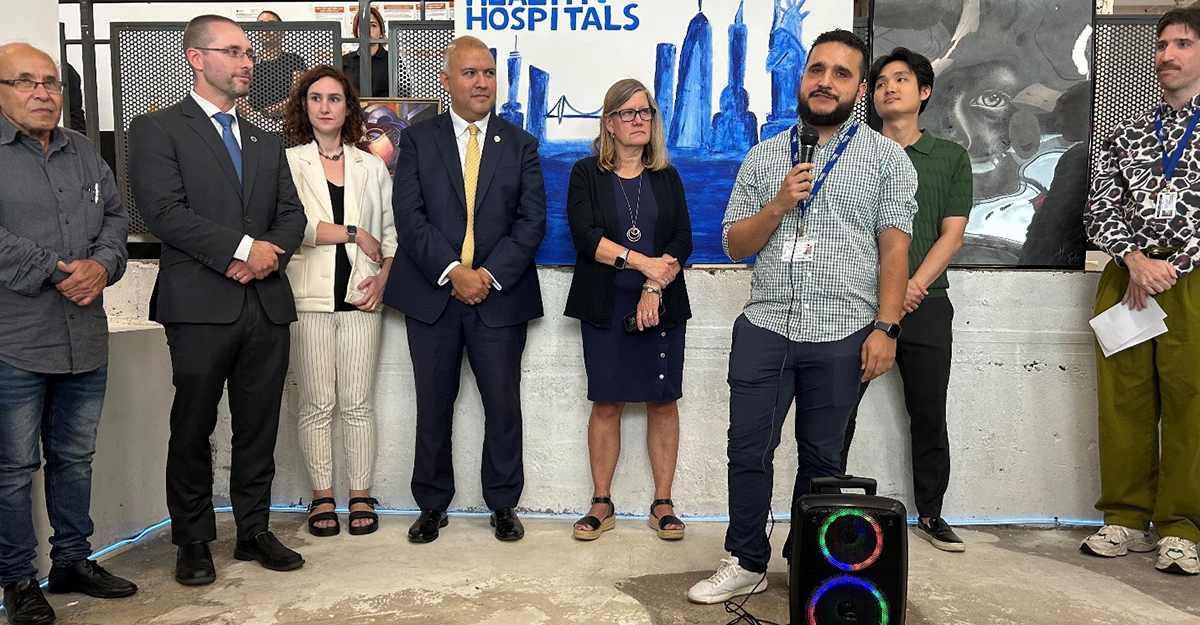

NYC Health + Hospitals Humanitarian Emergency Response and Relief Center (HERRC) program, in collaboration with the health system’s Arts in Medicine department, held an Asylum Seeker Art Exhibition last week featuring the works of two asylum seeker artists living at its Hall St. humanitarian center. The artists, Roger Miranda of Venezuela and Marcos Ferrera Batista of Brazil, have dedicatedly produced work over the several months they have lived at the facility. A video recap of the event and videos of remarks given by NYC Health + Hospitals and New York City leadership can be found here. The Hall St. humanitarian center, which opened in September 2023, currently houses approximately 3,200 asylum seekers, including over 200 families with children.
“Arts and culture have helped draw communities together for generations,” said Deputy Mayor for Health and Human Services Anne Williams-Isom. “Whether it is the sharing of a meal, listening to musical sounds from around the world, going to an art show, or so many other ways, we share a bit of culture with our neighbors. These art exhibits help us reflect on our common humanity and add to the multicultural richness that is New York City.”
“There are approximately 23,000 asylum seekers from over 160 countries around the world living at our humanitarian centers, but Roger and Marcos remind us that people are not numbers, and each of us has our own story,” said Ted Long, MD, MHS, Senior Vice President, Ambulatory Care and Population Health, NYC Health + Hospitals. “What is special about this art exhibition is that Roger and Marcos give us a glimpse of the world through their eyes, and we see both the fear and determination that people feel on their journey here. Unique as all of our guests are, Roger and Marcos remind us that we all have so much more in common than our differences, including our common hope to pursue a better life for ourselves and our families. It is our mission to help them find it. I am so proud of my team and grateful to our partners who came together to provide a platform for these artists to share their vision with us.”
“Art is a universal language. It allows individuals to voice their experiences and heartfelt stories through a meaningful expression. Roger Miranda and Marcos Ferrera Batista were courageous enough to express their perseverance and diverse journeys at the Hall St. humanitarian center,” said Manuel Castro, Commissioner of the NYC Mayor’s Office of Immigrant Affairs. “I’d like to thank NYC Health + Hospitals and their team for their care to all arriving migrants and for providing a platform for our newest New Yorkers to share their art.”
“The research is clear: both active and passive participation in the arts enhances mental health, fosters empathy, and alleviates stress,” said Larissa Trinder, Assistant Vice President Arts in Medicine, NYC Health + Hospitals. “The Arts in Medicine Department is proud to support this exhibition by artists Roger Miranda and Marcos Ferrera Batista, as it works to advance a healing community through the public health system’s Humanitarian Emergency Response and Relief Center program.”
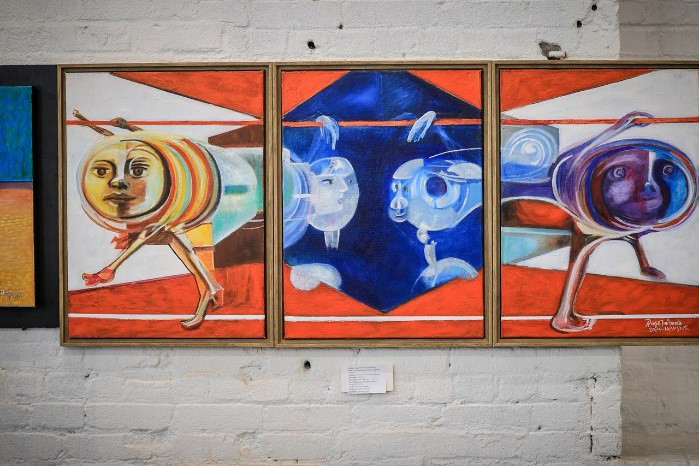
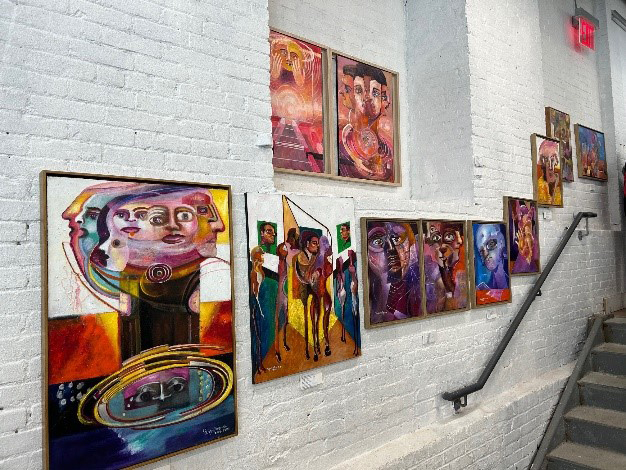
Roger Miranda’s work includes abstract paintings that portray the difficulties he experienced during his global migration and self-portraits which explore the complexity of the artist’s self-perception after being displaced.
Artist Roger Miranda of Venezuela reached the United States in February 2024 and immediately traveled to New York City. He earned a PhD in pedagogy in 1981 and went on to teach art and education to high school and university students for the next thirty years. Roger has been making art for over four decades, showing his work in galleries across South America. His work investigates political, educational, economic, and cultural problems in Venezuela and other countries he has called home.
The first series of his collection, “Immigración,” offers an abstract portrayal of the difficulties he experienced during his global migration and continues to confront adjusting to life in New York City. The second series, “Percepción Psicológica,” features a series of abstracted self-portraits which explore the complexity of the artist’s self-perception after being displaced. Roger hopes his artwork fosters empathy for the less fortunate, and particularly those facing the unique challenges of pursuing a better life in a new country. He plans to continue to show his artwork internationally, presenting in contemporary art galleries to help people understand how art, like the asylum seeker experience, continuously evolves.
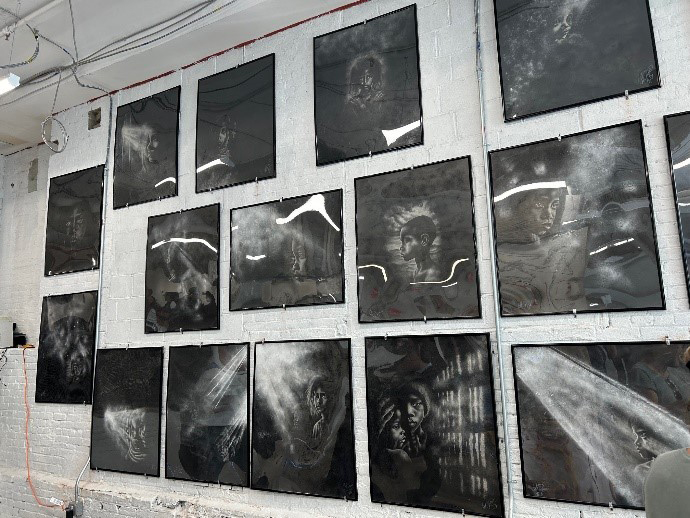
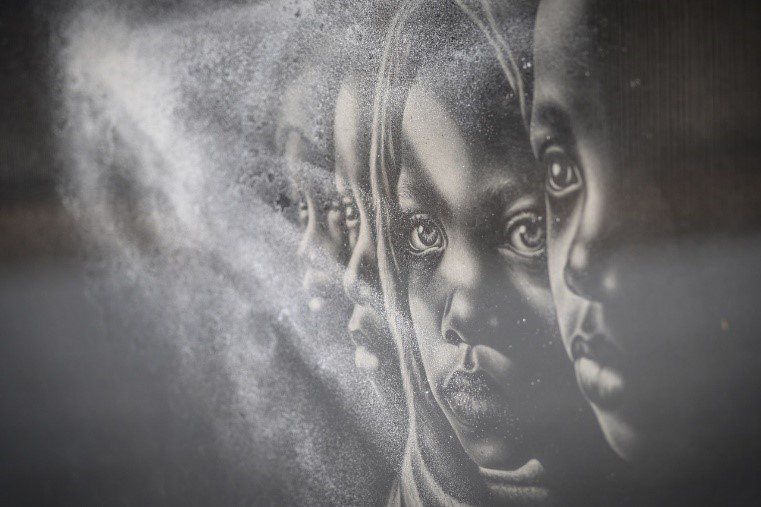
Artist Marcos Ferrera Batista’s collection of surrealistic portraits capture a glimpse of the love, hope, agony, anxiety, fear, and vulnerability asylum seekers, and especially children, experience during their journey.
Artist Marcos Ferrera Batista of Brazil entered the United States in July 2023 and arrived in New York City that October. He has been making art since the age of nine and has travelled extensively across South America. His experiences as an artist include touring with a circus troupe, playing African drums with the samba-reggae band “Olodum,” and recording music with groups across a range of genres. Throughout his life, art has provided a form of therapy and storytelling.
His collection of surrealistic, chiaroscuro portraits drawn in charcoal and pencil reflects his memories of the hundreds of asylum seekers he met crossing through thirteen countries to reach the United States. Each face, cast dramatically in light, captures a glimpse of the love, hope, agony, anxiety, fear, and vulnerability asylum seekers, and especially children, experience during their journey. For many, the path is fraught with the perils of violence, abuse, discrimination, extortion, and of navigating dense jungles, harsh deserts, and swift river crossings. Marcos hopes the depth of expressions in his portraits can help others better understand the asylum seeker experience and that his work can help support vulnerable communities. He recalled a saying his mom often shared: “Siempre hay un zapato viejo para un pie cansado,” or there’s always an old shoe for a tired foot. For Marcos, with resolve and creativity, every challenge can be overcome.
“Our team members must juggle many responsibilities in order to look after our over 3,000 guests, whether managing staffing, shifting services, problem solving on the fly, mediating conflicts, or responding to emergencies,” said Santiago Bedoya Velez, NYC Health + Hospitals Deputy Director of the Hall St. humanitarian center. “But more than anything, caring for our guests requires our staff to have the ability to thoughtfully listen, learn, and respond. For Roger and Marcos, that meant finding a space for them to make and store their art without disrupting their neighbors, and for every guest that means being able to show up however and whenever they need. I am so proud of and thankful for my team who generously provide the support and compassion for our guests to feel welcomed, express their talents, and follow their dreams, whatever those may be.”
NYC Health + Hospitals Humanitarian Emergency Response and Relief Center (HERRC) program accommodates approximately 23,000 asylum seekers living in its 13 humanitarian centers. In addition, the HERRC program oversees the city’s Arrival Center, which has received and provided medical, behavioral health, social, casework, and resettlement services to over 160,000 newly arriving asylum seekers from over 160 countries since the facility opened its doors in May 2023.
Across NYC Health + Hospitals 13 humanitarian centers, our staff maintain a commitment to ensuring that all of our guests, the majority of whom are families with children, receive compassionate, dignified care. Our humanitarian centers offer comprehensive services to support asylum seekers’ journey toward a better life, including medical services, case management services, food and nutritional support, language services, mental health resources, school enrollment assistance, social and afterschool programming, and aid in family reunification.
###
MEDIA CONTACT: Press Office
#155-24
About NYC Health + Hospitals
NYC Health + Hospitals is the largest public health care system in the nation serving more than a million New Yorkers annually in more than 70 patient care locations across the city’s five boroughs. A robust network of outpatient, neighborhood-based primary and specialty care centers anchors care coordination with the system’s trauma centers, nursing homes, post-acute care centers, home care agency, and MetroPlus health plan—all supported by 11 essential hospitals. Its diverse workforce of more than 43,000 employees is uniquely focused on empowering New Yorkers, without exception, to live the healthiest life possible. For more information, visit www.nychealthandhospitals.org and stay connected on Facebook, Twitter, Instagram and LinkedIn.
About NYC Health + Hospitals’ Arts in Medicine Department
The Arts in Medicine department at NYC Health + Hospitals seeks to foster the emotional well-being and promote healing and wellness for all patients and their families, employees, and the greater community by utilizing the arts, including literary, visual, and performing arts throughout the health care system. In addition to managing the system’s significant visual arts collection, the Arts in Medicine department encourages evidenced based practices and provides technical assistance to all of the system’s health care facilities and clinics. This is accomplished by combining artistic innovation and education into a comprehensive health care continuum that supports the healing benefits of the arts. For more information, visit https://www.nychealthandhospitals.org/artsinmedicine/.
